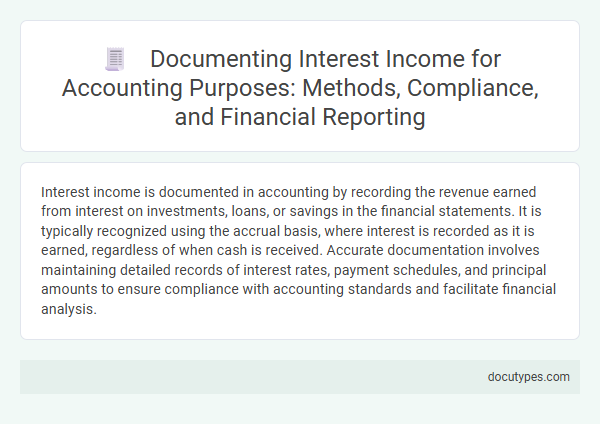Interest income is documented in accounting by recording the revenue earned from interest on investments, loans, or savings in the financial statements. It is typically recognized using the accrual basis, where interest is recorded as it is earned, regardless of when cash is received. Accurate documentation involves maintaining detailed records of interest rates, payment schedules, and principal amounts to ensure compliance with accounting standards and facilitate financial analysis.
Introduction to Documenting Interest Income
Interest income plays a crucial role in the financial statements of businesses and individuals. Accurate documentation of this income ensures compliance with accounting standards and tax regulations.
You must record interest income clearly to maintain transparent financial records. This involves capturing details such as the source of interest, amount earned, and the date of receipt. Proper documentation supports audit trails and aids in financial analysis and reporting.
Key Methods for Recording Interest Income
Interest income is recorded to accurately reflect earnings from financial assets in accounting records. Proper documentation ensures compliance with accounting standards and aids financial analysis.
- Accrual Method - Interest income is recorded when earned, regardless of cash receipt, matching revenue with the period it relates to.
- Cash Method - Interest income is documented only when cash is received, simplifying bookkeeping but potentially distorting earnings timing.
- Amortized Cost Method - Interest income is recognized by amortizing premiums or discounts on financial instruments over time to reflect true yield.
Accounting Standards Governing Interest Income
Interest income is recorded according to specific accounting standards to ensure accurate financial reporting and compliance. Proper documentation involves recognizing interest revenue when earned, regardless of cash receipt timing.
- IFRS 9 Financial Instruments - Requires the effective interest method to measure and recognize interest income on financial assets.
- ASC Topic 310 (U.S. GAAP) - Mandates interest income recognition based on the contractual interest rate applied to the outstanding principal balance.
- Disclosure Requirements - Both IFRS and U.S. GAAP require separate disclosure of interest income in financial statements to enhance transparency.
Best Practices in Interest Income Documentation
Interest income must be accurately documented to ensure compliance with accounting standards and tax regulations. Detailed records include the principal amount, interest rate, calculation period, and payment dates.
Best practices involve maintaining timely and organized ledgers or digital accounting systems to track earned interest. Clear documentation supports audit processes and provides a transparent financial overview for stakeholders.
Compliance Requirements for Financial Institutions
Interest income must be meticulously documented by financial institutions to ensure compliance with regulatory standards and accurate financial reporting. Proper documentation supports transparency and facilitates audits by regulatory bodies.
- Accurate recording - Interest income is recorded in the financial statements according to the accrual accounting principle to reflect earned revenue accurately.
- Regulatory reporting - Financial institutions must report interest income in compliance with guidelines from bodies such as the SEC and Basel Committee to meet legal requirements.
- Audit trail maintenance - Maintaining detailed records of interest transactions helps demonstrate compliance during both internal and external audits.
Comprehensive documentation of interest income safeguards financial institutions against regulatory risks and enhances the integrity of financial statements.
Common Challenges in Reporting Interest Income
Documenting interest income accurately is essential for maintaining transparent financial records and ensuring compliance with accounting standards such as GAAP or IFRS. Common challenges in reporting interest income include timing differences between accrual and cash basis accounting, misclassification of interest types, and difficulties in tracking interest from multiple accounts or instruments. These issues can lead to discrepancies in financial statements, affecting the reliability of reported earnings and tax calculations.
Tools and Software for Interest Income Management
How is interest income documented for accounting purposes using modern tools and software? Accurate documentation of interest income relies on specialized accounting software designed to automate calculation and recording processes. These tools ensure compliance with financial standards by integrating transaction data directly from banks and financial institutions.
What are the benefits of using software for managing interest income? Interest income management software enhances accuracy, reduces manual errors, and provides detailed reports essential for audits and tax filings. Features such as real-time tracking, customizable interest rate settings, and automated reconciliations streamline your financial workflow.
Which software options are best suited for interest income documentation? Popular accounting platforms like QuickBooks, Xero, and specialized financial management tools such as Intuit TurboTax and Microsoft Dynamics offer built-in modules for interest income tracking. Many of these platforms support multi-currency transactions and interest rate adjustments, supporting various financial scenarios.
Auditing Interest Income: Procedures and Checklists
| Aspect | Details |
|---|---|
| Definition of Interest Income | Interest income represents earnings generated from investments such as loans, bonds, savings accounts, and fixed deposits. |
| Documentation Requirements | Interest income is documented through bank statements, loan agreements, investment certificates, and interest calculation schedules. |
| Accounting Records | Recorded in the income statement under non-operating income. Supporting entries in the general ledger include debtor accounts, accrued interest receivable, and cash receipts. |
| Auditing Objective | Verify accuracy, completeness, existence, and classification of interest income reported in financial statements. |
| Audit Procedures |
|
| Audit Checklist Items |
|
| Common Audit Findings | Misclassification of interest income, incomplete documentation, incorrect interest calculations, timing errors in recognition. |
| Conclusion | Proper audit of interest income ensures reliability of financial reporting and compliance with relevant accounting principles and regulations. |
Impact of Improper Documentation on Financial Statements
Interest income is recorded in accounting by recognizing earned interest through accurate documentation such as bank statements, loan agreements, and interest calculation schedules. Proper documentation ensures that interest income is reflected correctly in the financial statements, supporting reliable revenue reporting.
Improper documentation of interest income can lead to misstated revenues and distorted financial performance, affecting key metrics like net income and earnings per share. Inaccuracies may trigger compliance issues, audit adjustments, and reduced stakeholder confidence in the company's financial reliability.
How Is Interest Income Documented for Accounting Purposes? Infographic

